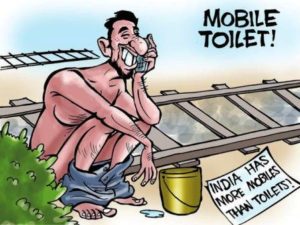95 per cent of the world’s people now live in areas covered by mobile signals. The number of mobile subscriptions worldwide rose to an estimated 7.1 billion in 2015 — it has more than trebled from 2.2 billion in 2005. So says the International Telecommunications Union (ITU), a United Nations agency, which launched the 2015 edition of the Measuring the Information Society Report in November.
A World bank report points out that 8 in 10 people in the developing world own a mobile phone. South Asia’s recent ICT gains are impressive, but much more needs to be done to bridge the digital divide.
But many of South Asia’s 1.7 billion people still struggle to access modern digital services. National level statistics often mask disparities — for example, between urban and rural areas, and between men and women.
These gaps are highlighted in two global reports. Both reports acknowledge that there are still substantial digital divides, both between and within countries, in the penetration rates of both fixed and mobile telephones, as well as of broadband internet.
The least developed countries (LDCs) – those with a per capita gross national income of less than US $ 1,035, are the most disadvantaged in this aspect. That category includes four countries in South Asia: Afghanistan, Bangladesh, Bhutan and Nepal.
By 2015, 40 per cent of the world’s population was accessing the Internet, most of them through mobile devices. In South Asia, it remains less than half the global rate (16.6 per cent in 2014) according to World Bank data.
In January 2016, the World Bank released World Development Report 2016 (WDR 2016) that further probes digital dividends — the broader development benefits from using digital technologies.
The report collates evidence for rapid spread of such technologies in most parts of the world but notes how their adoption alone is not enough to transform societies and economies.
To get the most out of the digital revolution, countries also need to work on “analogue complements” – such as strengthening regulations that ensure competition among businesses, adapting workers’ skills to the demands of the new economy, and ensuring that institutions are accountable.
Analysing national level official statistics, WDR 2016 shows how the digital divides persist across income, age, geography and gender.
There has been progress, but it is uneven. For example, 28 per cent of developing country residents say they can access the internet at home. In advanced economies, that rate is now 80 per cent.
The good news is that mobile phones have cut cross most income and societal barriers: on average, 8 in 10 people in the developing world own a mobile phone. A mix of smartphones and low-end ‘feature phones’ today connect more than 60 per cent of the world’s people who did not have a landline phone in 2000.
The report does a cost comparison of mobile phone owning and using. It finds that six of the 10 cheapest countries to use a mobile phone are in South Asia (in ascending order: Sri Lanka, Bangladesh, Nepal, Bhutan, India and Pakistan). In all these, the cost of ownership is typically below US$ 5 a month.
In South Asia, this has been enabled by the ‘budget telecom model’ where low cost technologies coupled with business process innovations helped telecom operators to reduce costs. Introducing pre-paid packages was a critical element: it allowed small and irregular payments, eliminating transaction costs for companies and simplifying ownership for new users.
Factors like geography and population density “appear to matter less than might be expected”, the report says, as mountainous Bhutan and Nepal are among the cheapest countries for mobile services.
WDR 2016 confirms that the spread of mobile phones is creating more interconnected societies. While all regions are converging in mobile phone use, “South Asia and Sub-Saharan Africa lag far behind in internet access”.


